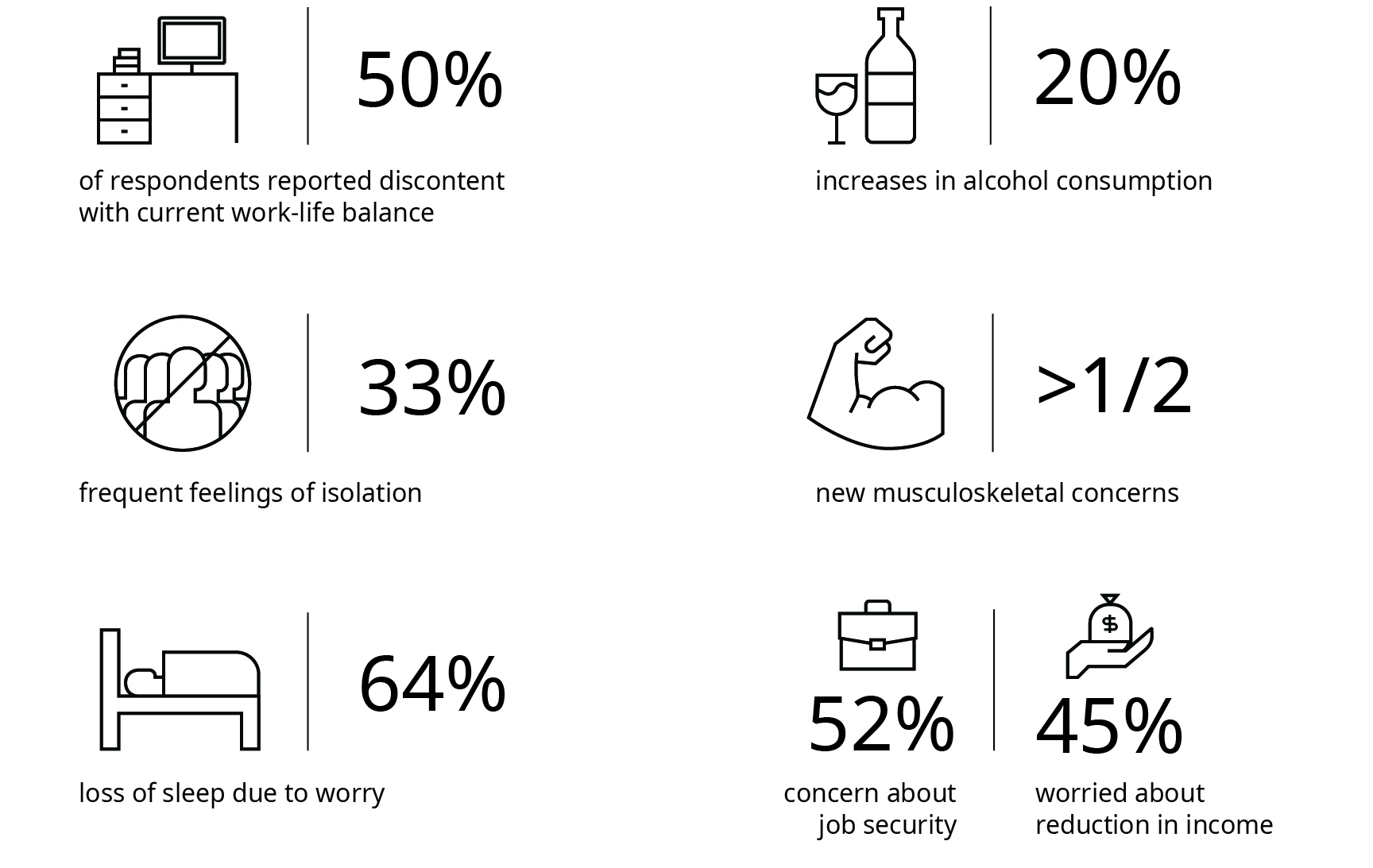For the Retailer, there was no simple answer to the question — “What steps do I take on coronavirus to ensure the well-being of my people and keep the business operating?“ — Yet, retailers had to formulate a response.
Digital fluency competency became key, while in-store customer service competencies became less relevant. Fulfillment logistics went from one of several core processes to virtually the entirety of operational concerns.
When COVID-19 spread across the world, retailers were met with a number of disruptions and challenges:
- Supply chains were stressed, and many were unable to cope
- Sales at physical stores shifted from closed store fronts to ecommerce warehouses
- Essential retailers had products of all shapes and sizes being sold out in minutes
- Last mile delivery experienced significant demand growth
- Fulfillment centers became warehouses for some products and expressways for essential products to meet demand
- Employees were needed to maintain operations, but protecting their health was a major challenge
Against this backdrop of systemic stress and the duty of care for employees, the retailer response was varied in proactivity and focus:
- Develop pay premiums for front-line workers
- Continue wages and benefit premiums even though brick and mortar locations were closed
- Immediately create work-from-home guidelines
- Freeze merit increases or reducing pay at headquarters
- Do little and “wait and see”
“Wait and see” was the most frequent response in each of Mercer’s Retail COVID-19 Surveys. When businesses reached for their business continuity plan, there generally was no section that outlined the steps for a pandemic response, and certainly none of this magnitude. Retailers were in a frenzy to figure out how to maintain operations and provide value to customers, but few took bold action for fear that a wrong step might harm employees and the brand. Yet, in our experience, the retail organization that hesitates to reinvent for this moment and the future which awaits will have missed the moment.
Over the last few months, as the dust has begun to settle, four key areas in human capital are emerging as critical front-and-center issue for retailers wishing to create a brighter future for their people and ensure the sustainability of their businesses.
Organizational Readiness
Given the comprehensive structural nature of the changes likely to come, executives will need to revisit fundamentally their organizational framework along three critical dimensions.
First, companies must consider re-balancing priorities within and across functions. For example, resources within the sales department will shift towards the online channel in order to offer virtual shopping experiences. This raises questions about the role and requirements for the traditional sales teams. Across functions such as Sales and Marketing, the need to create a much stronger cross-functional connection is likely to emerge as a key requirement for success going forward.
Second, overall resource levels will need to be a key area of scrutiny for the executive teams. Often, retailers allow complex organizational setups to evolve and entrench themselves over the years across geographies, products, sectors, and oftentimes brands or business lines. Historically, an internal race for primacy took place, often leading to a proliferation of resources created to serve and respond to parochial interests. Resetting and simplifying such organizational constructs is likely to be a key priority going forward.
Third, the extended phase of working from home in 2020 has provided lessons on more flexible, digital, and potentially more efficient working methods. During this crisis, we are seeing many companies that have not met the challenge of enabling effective work at a distance. Notable examples have been organizations unable to equip staff with laptops for working at home, resulting in almost complete loss of human resources when governmental decrees shut down corporate offices indefinitely. Learning the lessons of distance working, what needs to be in-office and what not, and how technology can re-define ways of working will be crucial elements of post- COVID-19 agendas.
Supply Chain Readiness
Most retailers have invested significantly to upgrade supply chain capabilities in recent years. These initiatives were often geared towards cost reduction through better forecasting systems, LCC sourcing and manufacturing strategies, or a reduction of lead times for retail or end customers. There is now more to do.
The current crisis has and is creating challenges related to direct shipment capabilities for small lot sizes, as needed for direct-to-consumer businesses. Even more pressing for executives will be how to handle overstock or aging stock, now a massive issue in the fashion sector. Trade-offs will have to be made to allow for “decent” sellthrough of previous models vs. emerging from the crisis with fresh merchandise. Companies will not be able to rely solely on standard clearance approaches — creativity and innovation will be required. Possible approaches include revisiting launch cycles, storing seasonal products for next year, or transshipments into other markets.
Finally, it will be important to draw the right learnings from the crisis. The 2008 financial crisis resulted in a race for supply chain speed, and faster supply chains have proven to be more responsive to volatility in demand. Given the contraction of consumer demand on the one hand but increasing supply chain requirements by business partners and certain channels, such as direct to-consumer, on the other, consumer goods companies must strike the right balance between the short-term need for cost reduction and longer-term competitive differentiation.
Fulfillment Infrastructure and Delivery Operations
With brick and mortar in lock-down, fulfillment centers became the new storefront and the new crisis. Employees worked in close physical contact, and there were staffing storages. Yet consumer demand remained. To meet this demand, retailers temporarily adapted their talent model, the fulfillment infrastructure, and delivery operations by automating processes designed to support social distancing efforts, as well as meet online revenue growth. At the end of 2019, ecommerce represented some 16% of total retail sales. From March to May 2020 online sales grew near triple digits year-over-year. “Consumer spending has moved strongly towards the online and mobile channels by between five and ten percentage points”.
These temporary shifts have left retailers thinking about making them permanent, especially in the areas of job redesign and talent strategies linked to the online and digital environment.
- Job Redesign:
- Instead of the sales associate waiting on customers in stores, retailers are offering employees the option to re-deploy to e-commerce roles. The roles could include virtual selling, showing the products online or working in a fulfillment center. Long gone are the days that working in a warehouse fulfillment center consisted merely of lifting boxes and loading trucks. Today’s jobs in fulfillment warehouses and customer service include a managing significant level of automation and ensuring the customer has a positive purchasing and delivery experience.
- With customers expecting product delivery quickly, networking planning has become increasingly important, and complex. Lack of data, lack of a comprehensive approach to analyze and synthesize, and lack of proper and efficient ways to visualize valuable data, analytics and insights are significant challenges. New job types and skills will continue to emerge to use robotics and automate workflow processes through agile methodology. While the future is digital, it will be created and sustained by humans.
- Talent Strategies:
- Retail organizations are constantly struggling with cost and efficiency. When you add gaps in talent availability and skill capability readiness in the new COVID-19 environment, traditional staffing models are not sustainable. The staffing models must be more than just tweaked. Design think through all the possibilities – known and unknown -- and implement staffing models designed for a long-term pandemic and which addresses talent shortages, and adjustments to work policies for work-from-home/office will be critical.
- In an effort to be more resilient for the next pandemic or other major business disruption, organizations must prepare today for tomorrow. It requires developing new standards for health & safety and pandemic planning.
The Work Experience
For employees, safety and motivation are top of mind. They are working long hours under great pressure and unsurprisingly pushing back on employers whom they perceive as not doing enough to ensure safety, or provide sufficient personal protective equipment (PPE) and timely testing.
Leaders should redesign their operations based on data provided by their most valuable sources of proprietary insights — their employees. When leaders take this bottom-up approach, we have found they not only cut costs significantly but also realize their goals more rapidly because managers and employees are motivated to help. Changes are then also more likely to stick.
In March 2020, Mercer conducted a comprehensive digital focus group of 256 organizations to comment on employee concerns and their priorities about their jobs in the wake of the COVID-19 pandemic. The results were illuminating.
- 40% Were concerned with the impact of remote work on culture and collaboration
- 36% Worried about the impact of remote work on work/life balance
- 37% Felt concern about potential layoffs
- 30% Think the outbreak will limit investments in training and development
- 24% Were fearful that the economic impact of COVID will lead to pay reductions
Exhibit 1: Risk Factors Since the Emergence of COVID-19

Source: Institute for Employment Studies
Employee Wellbeing (Snapshot)
At the height of the pandemic, much of the world was subjected to stay-at-home or similar government directives. The abrupt nature of these directives has resulted in behaviors which constitute health risks such as less exercise, and more food and alcohol consumption. Such behaviors can impact worker productivity. Employers are enhancing their mental health support as employees report cases of loneliness (being separated from others) and anxiety (fear of loss of job or financial impact). Prior to COVID-19, wellness initiatives were a “nice-to-have”, but are now becoming expected – and something likely to yield positive results for companies and staff after the pandemic has ended.
Employees want a working experience that is inclusive and meaningful. It is therefore critical to build a sense of belonging and purpose. Leading companies are listening to their employees and collecting data on their concerns and desires to develop new approaches, ones to enable employees to thrive in the new work experience.
Such approach actions have included:
- Demonstrate commitment to employees through works and actions that aim to earn trust and loyalty
- Listen to employee perspectives and co-create an organizational purpose that can become a call-to-arms for the organization
- Invite employees to participate in worthwhile initiatives that help them feel part of something bigger than themselves, and give them an important role to play
The HR community has a critical seat at the table to help ensure the operational success of the organization. Retailers seeking a better work experience will develop an engagement program based in listening and inclusion. Beyond financial donations and statements, the workforce of the future seeks to be part of an “employer of choice” that hears employees, includes them in decisions affecting the future of the business and their livelihood, and prepares them for the future of work.
Conclusion
The world has changed, and addressing the challenges created going forward will require transformative, not incremental approaches. Optimizing the status quo is unlikely to be enough. Online and ecommerce will be the driver and set the direction. For retailers, this means that the first step should be to reimagine the company as an online entity first, then think about what to do with stores. A mission-driven company is “a competitive advantage” that will ultimately create shareholder value. There is currently an amazing opportunity to reinvent the retail future by looking closely at processes, job skills and work experience. The shared futures of employers and employees happen at the intersection of a common purpose, a valued job, and a meaningful career. It is critical they come together to thrive now and in the future.




.png.imgix.profileSmall.png)